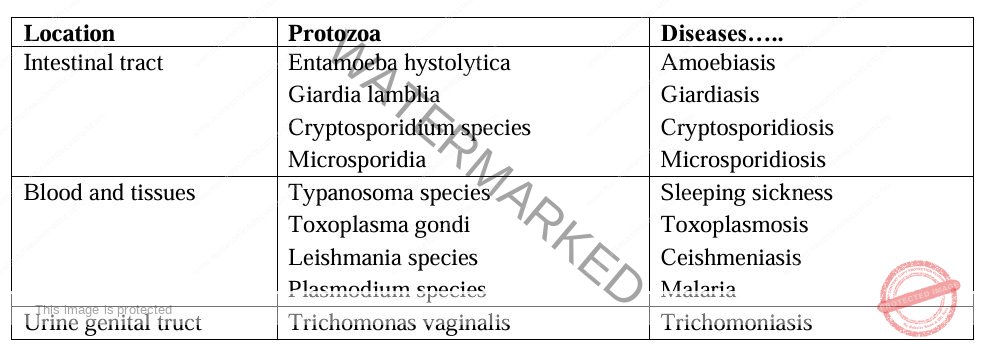Microbiology
Subtopic:
Pathogenic Microorganisms
Important terminologies:
PATHOGEN: Refers to microorganisms capable of causing disease
PATHOGENICITY: Refers to the ability of microorganisms to cause disease
Virulence: a measure of microbe’s ability to cause disease
Microorganisms can be classified as Non pathogens (One which do not cause disease) or Pathogens (microorganisms capable of causing disease).
Pathogens are further divided into two:
Opportunistic pathogens: Are microorganisms capable of causing disease only when the host’s defenses are compromised. Majority of the opportunistic pathogens are part of the normal floras as below:

PRIMARY PATHOGENS are microorganisms capable of causing disease even when the hosts defense mechanisms are interact (health person). Primary pathogens have means of overcoming the defense mechanisms and some can affect even animals as below:

Common Protozoa and their Associated Diseases

Are disease causes by fungi. Are classified into three:
Superficial infections; are localized to teratinized tissues such as skin, nails and hairs. Are caused by dermatophytes and candida albican.
Subcutaneous infection; are limited to subcutaneous tissues though they may spread to the surrounding skin and bones.
Systemic infections; occurs when pathogenic fungi enter the body and infact internal organs such as lungs, brains etc. are further divided into two mainly. Primary which occur in healthy individuals and opportunistic which occur in immunocom promised patients. Examples of opportunistic pathogens: Cryptococcusis, Aspergillosis, Systematic candiasis, pneumocystis (pcp).
Classification of Dermatophyte Infections: They were previously called tineas/ ringworms. Their growth is enhanced by foot and humid conditions, poor personal hygiene. Are classified as below;
Tineacorpris e.g trichophytonrubrum and e.floccosum which affects their non hairly, smooth part of the skin.
Tineapedis which affect el webs and the sole e.g I.rubrum and epidermophytonfloccossum.
Tineacapitis of microsporuumcanis, trichophyton and mentagrophytes which affects el scalp.
Tineacruris. Affects the grain e.g t.trubrum. e.floccosum and frichphytonmentagraphytes.
Tineaungulium affects the board area e.g Trichophytonmentagraphytes.
Tineamanuum. Affects the finger wbbs e.g tirubrum.
Related Topics
- Concepts of Microbiology
- Classification and Types of Microorganisms
- Pathogenic Microorganisms
- Normal Flora
- Characteristics and Mode of Spread of Disease-Causing Microorganisms
- Pathological Effects of Microorganisms
- Simple Laboratory Tests
- Infection Prevention and Control
- Introduction to Immunity
- Antibodies
- Principles of Immunization
Get in Touch
(+256) 790 036 252
(+256) 748 324 644
Info@nursesonlinediscussion.com
Kampala ,Uganda
© 2025 Nurses online discussion. All Rights Reserved Design & Developed by Opensigma.co

